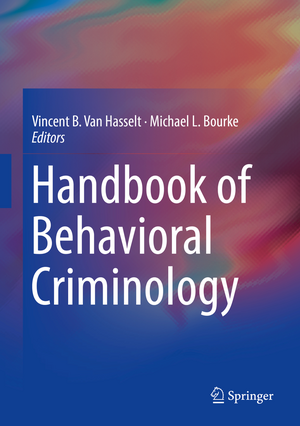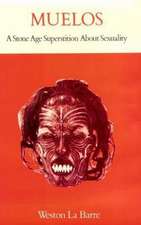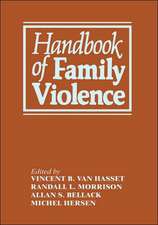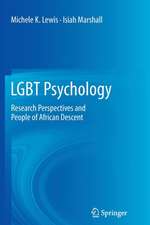Handbook of Behavioral Criminology
Editat de Vincent B. Van Hasselt, Michael L. Bourkeen Limba Engleză Hardback – 22 feb 2018
Among the topics in the Handbook:
· Dyadic conceptualization, measurement, and analysis of family violence. · School bullying and cyberbullying: prevalence, characteristics, outcomes, and prevention.
· A cultural and psychological perspective on mass murder. · Young people displaying problematic sexual behavior: the research and their words.
· Child physical abuse and neglect.
· Criminal interviewing and interrogation in serious crime investigations.
· Violence in correctional settings.
· Foundations of threat assessment and management.
The Handbook of Behavioral Criminology is a meticulous resource for researchers in criminology, psychology, sociology, and related fields. It also informs developers of crime prevention programs and practitioners assessing and intervening with criminal clients and in correctional facilities.
| Toate formatele și edițiile | Preț | Express |
|---|---|---|
| Paperback (1) | 2501.00 lei 6-8 săpt. | |
| Springer International Publishing – 16 mar 2019 | 2501.00 lei 6-8 săpt. | |
| Hardback (1) | 2508.88 lei 6-8 săpt. | |
| Springer International Publishing – 22 feb 2018 | 2508.88 lei 6-8 săpt. |
Preț: 2508.88 lei
Preț vechi: 3059.62 lei
-18% Nou
480.06€ • 501.23$ • 397.32£
Carte tipărită la comandă
Livrare economică 04-18 aprilie
Specificații
ISBN-10: 3319616234
Pagini: 771
Ilustrații: XVI, 762 p. 22 illus., 8 illus. in color.
Dimensiuni: 178 x 254 x 46 mm
Greutate: 1.56 kg
Ediția:1st ed. 2017
Editura: Springer International Publishing
Colecția Springer
Locul publicării:Cham, Switzerland
Cuprins
Part I: Overview and Perspectives.- Overview.- Dyadic Conceptualization, Measurement, and Analysis of Family Violence.- Role of Neurobiological Factors.- Psychological Theories of Criminal Behavior.- Behavioral Science Research Methods.- Part II: Violent Crime by Children and Adolescents.- Animal Cruelty Offenders.- Child and Adolescent Firesetting.- School Bullying and Cyberbullying: Prevalence, Characteristics, Outcomes, and Prevention.- Child and Adolescent Homicide.- Part III: Homicide.- A Cultural and Psychological Perspective on Mass Murder.- Maternal Filicide.- Homicide-Suicide.- Criminal Investigative Analysis: A Move Toward a Scientific, Multidisciplinary Model.- Part IV: Sexual Deviance and Assault.- Sex Work and Adult Prostitution: From Entry to Exit.- Child Sexual Abuse and Molestation: The Spiral of Abuse.- The Commercial Sexual Exploitation of Children.- Female Sexual Offenders.-Young People Displaying Problematic Sexual Behavior: The Research and their Words.- Internet Sexual Offending.- Part V: Family Violence.- Sibling Abuse.- Child Physical Abuse and Neglect.- The Medical Aspects of Victim Vulnerabilities in Child Sexual Exploitation.- Domestic Violence.- Elder Abuse.- Part VI: Behavioral Intelligence.- Forensic Linguistics.- Investigative Interviewing.- Criminal Interviewing and Interrogation in Serious Crime Investigations.- Management and Mitigation of Insider Threats.- Investigative Uses of Hypnosis.- Part VII: Violence in Specific Settings.- Violence and the Military.- Workplace Violence.- School Violence.- Violence in Correctional Settings.- Part VIII: Special Topics.- Crisis (Hostage) Negotiations.- Risk Assessment: Law, Theory, and Assessment.- Foundations of Threat Assessment and Management.- Neuropsychology of Violence.- Alcohol, Drugs, and Crime.- Criminal Profiling Investigative Strategies for Arson Investigations.- Child Molesters Who Abduct: A Behavioral Analysis.- Terrorism and Violent Extremism.
Notă biografică
Vincent B. Van Hasselt, Ph.D., is Professor of Psychology and Director of the Family Violence Program at Nova Southeastern University. He is also editor of Aggression and Violent Behavior: A Review Journal and Journal of Child and Adolescent Substance Abuse. Dr. Van Hasselt has served as lecturer and consultant to the FBI’s Behavioral Science, Crisis Negotiation, and Law Enforcement Communication Units, and is part of the Bureau’s Crisis Prevention and Intervention Program. His clinical and research interests are in the areas of crisis and hostage negotiations, police stress and mental health, critical incident response, and the emerging field of behavioral criminology. Dr. Van Hasselt is also a certified police officer with the Plantation, Florida, Police Department.
Textul de pe ultima copertă
This multidisciplinary volume assembles current findings on violent crime, behavioral, biological, and sociological perspectives on its causes, and effective methods of intervention and prevention. Noted experts across diverse fields apply a behavioral criminology lens to examine crimes committed by minors, extremely violent offenses, sexual offending, violence in families, violence in high-risk settings, and crimes of recent and emerging interest. The work of mental health practitioners and researchers is shown informing law enforcement response to crime in interrogation, investigative analysis, hostage negotiations, and other core strategies. In addition, chapters pay special attention to criminal activities that violate traditional geographic boundaries, from cyberstalking to sex trafficking to international terrorism. Among the topics in the Handbook:
· Dyadic conceptualization, measurement, and analysis of family violence. · School bullying and cyberbullying: prevalence, characteristics, outcomes, and prevention.
· A cultural and psychological perspective on mass murder. · Young people displaying problematic sexual behavior: the research and their words.
· Child physical abuse and neglect.
· Criminal interviewing and interrogation in serious crime investigations.
· Violence in correctional settings.
· Foundations of threat assessment and management.
The Handbook of Behavioral Criminology is a meticulous resource for researchers in criminology, psychology, sociology, and related fields. It also informs developers of crime prevention programs and practitioners assessing and intervening with criminal clients and in correctional facilities.
Caracteristici
Descriere
This multidisciplinary volume assembles current findings on violent crime, behavioral, biological, and sociological perspectives on its causes, and effective methods of intervention and prevention. Noted experts across diverse fields apply a behavioral criminology lens to examine crimes committed by minors, extremely violent offenses, sexual offending, violence in families, violence in high-risk settings, and crimes of recent and emerging interest. The work of mental health practitioners and researchers is shown informing law enforcement response to crime in interrogation, investigative analysis, hostage negotiations, and other core strategies. In addition, chapters pay special attention to criminal activities that violate traditional geographic boundaries, from cyberstalking to sex trafficking to international terrorism.
Among the topics in the Handbook:
· Dyadic conceptualization, measurement, and analysis of family violence. · School bullying and cyberbullying: prevalence, characteristics, outcomes, and prevention.
· A cultural and psychological perspective on mass murder. · Young people displaying problematic sexual behavior: the research and their words.
· Child physical abuse and neglect.
· Criminal interviewing and interrogation in serious crime investigations.
· Violence in correctional settings.
· Foundations of threat assessment and management.
The Handbook of Behavioral Criminology is a meticulous resource for researchers in criminology, psychology, sociology, and related fields. It also informs developers of crime prevention programs and practitioners assessing and intervening with criminal clients and in correctional facilities.


























